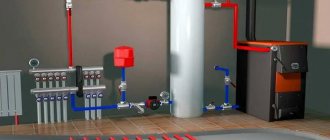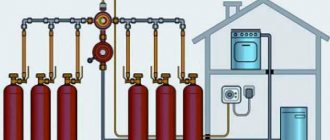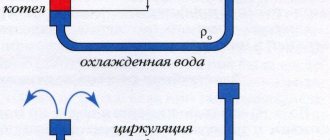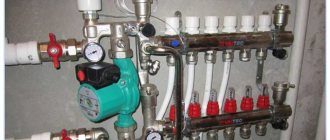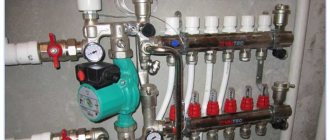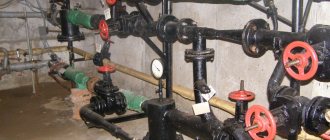A comfortable temperature in the rooms is necessary for living in a house, so the owners of private buildings, especially those in which not one floor, but two, are built, are thinking about ways to install heating for all rooms. A forced circulation heating scheme for a two-story house is an ideal option for maintaining the necessary heat at any time of the year.
Option for schematic heating of all floors
General information about the two-pipe heating system
Any heating system with a liquid coolant consists of one or more closed circuits connecting radiators and a boiler.
In a two-pipe distribution, hot coolant is supplied through one branch of the circuit and returned through the other, hence the name.
Diagram of a typical two-pipe heating system in a private house.
Classification signs:
- The organization of coolant movement is gravity and forced.
- Design – open or closed, horizontal or vertical.
- Pipe routing – radial, dead-end, ring.
By combining properties, you can achieve the best suitability for operating conditions.
Types of radiators for heating apartment buildings
In multi-storey buildings there is no single rule allowing the use of a specific type of radiator, so the choice is not particularly limited. The heating scheme of a multi-storey building is quite universal and has a good balance between temperature and pressure. The main models of radiators used in apartments include the following devices:
- Cast iron batteries
. Often used even in the most modern buildings. They are cheap and very easy to install: as a rule, apartment owners install this type of radiators themselves. - Steel heaters
. This option is a logical continuation of the development of new heating devices. Being more modern, steel heating panels demonstrate good aesthetic qualities, are quite reliable and practical. They combine very well with the control elements of the heating system. Experts agree that steel batteries can be called optimal for use in apartments. - Aluminum and bimetallic batteries
. Products made from aluminum are highly valued by owners of private houses and apartments. Aluminum batteries have the best performance when compared with previous options: excellent appearance, light weight and compactness are perfectly combined with high performance characteristics. The only disadvantage of these devices, which often scares off buyers, is the high cost. However, experts do not recommend saving on heating and believe that such an investment will pay off quite quickly.
Conclusion
The correct choice of batteries for a centralized heating system depends on the performance indicators that are inherent in the coolant in the given area. Knowing the cooling rate of the coolant and its movement, you can calculate the required number of radiator sections, its dimensions and material. We should not forget that when replacing heating devices, it is necessary to ensure that all rules are followed, since their violation can lead to defects in the system, and then the heating in the wall of a panel house will not perform its functions (read: “Heating pipes in the wall ").
It is also not recommended to carry out repair work in the heating system of an apartment building on your own, especially if it is heating within the walls of a panel house: practice shows that residents of houses, without the appropriate knowledge, are able to throw away an important element of the system, considering it unnecessary.
Centralized heating systems demonstrate good qualities, but they need to be constantly maintained in working order, and for this you need to monitor many indicators, including thermal insulation, wear and tear of equipment and regular replacement of worn-out elements.
Advantages and disadvantages
The pros and cons of a two-pipe system should be considered taking into account the operational properties and technical characteristics.
| Advantages | Flaws |
| Same coolant temperature in all radiators | Increased pipe consumption - 2 branches need to be led to the radiator, inlet and outlet |
| Adjusting the heat output of each battery | Large diameter riser pipes and supply pipes to the first radiators in the circuit |
| Low hydraulic resistance | |
| Operation of the entire system in case of failure of one or more radiators | |
| Use in high-rise buildings | |
| Flexibility of hose options – in the floor, in the walls, along the walls, under the ceiling and behind a false ceiling |
The table shows common to all two-pipe networks. However, each wiring option may have negative qualities that limit its use, which we will consider later.
How a single-pipe heating system works: we explain it in diagrams
Purpose and principle of operation of the elevator unit
It was said above that the water in the heating system of a multi-story building heats up to 130 degrees. But consumers do not need such a temperature, and heating the batteries to such a value is absolutely pointless, regardless of the number of floors: the heating system of a nine-story building in this case will not be different from any other. Everything is explained quite simply: the heating supply in multi-storey buildings is completed by a device that turns into a return circuit, which is called an elevator unit. What is the meaning of this node, and what functions are assigned to it?
The coolant heated to a high temperature enters the elevator unit, which, in its principle of operation, is similar to a dosing injector. It is after this process that the liquid carries out heat exchange. Coming out through the elevator nozzle, the coolant under high pressure exits through the return line.
In addition, through the same channel, the liquid is recirculated into the heating system. All these processes together make it possible to mix the coolant, bringing it to the optimal temperature, which is sufficient to heat all apartments. The use of an elevator unit in the scheme makes it possible to provide the highest quality heating in high-rise buildings, regardless of the number of floors.
Schemes of open and closed two-pipe heating systems
Coolant circulation is carried out in three ways:
- gravity (gravity);
- forced using a pump;
- combined.
In addition, systems are divided into open and closed. This indicator characterizes the interaction of the coolant and the atmosphere.
When heated, the volume of any coolant liquid increases. It is known that liquid is practically uncompressible, so to accommodate the “excess” a separate device is required - an expansion tank.
Open type
Scheme of a two-pipe open-type heating system.
In open systems, the tank is installed at the highest point, it is connected to the atmosphere by a pipe.
The advantages of an open system are simplicity and a minimum of additional devices. Any type of expansion tank can be used as an expansion tank.
.
Ready-made expansion tank for open-type CO.
Add water to the tank as needed. For this:
- install taps and connect the system to the water supply;
- add coolant through the opening hatch.
Attention! An open system must not be filled with antifreeze - evaporated gases can be toxic.
Closed type
In closed systems, a sealed expansion tank with an elastic diaphragm or balloon membrane inside is used. The membrane divides the device into 2 parts. Air is pumped into one chamber with a pump at a pressure of 1.2–1.5 atm, and the second is connected to the heating system pipe.
When the coolant heats up and expands, its excess fills the tank. When the temperature of the liquid drops, the membrane squeezes the coolant into the system. Preliminary injection of air into the tank allows you to maintain the pressure necessary for the operation of the boiler, the automation of which turns off the power at a pressure of less than 1.2 atm.
Antifreeze or glycols can be used in sealed structures.
Scheme of a two-pipe closed-type heating system.
In closed networks, the tank is located close to the boiler, which simplifies monitoring the performance of the entire structure.
Gravity flow schemes
Gravity (gravity) systems work due to the laws of physics. At normal atmospheric pressure, being heated to 50°C, water has a density of 988 kg/m3, and at 85°C - 968 kg/m3.
Scheme of a two-pipe open-type gravity system.
In the heating circuit, hot water (lighter) rises through the pipes, and the coolant cooled in the radiators moves down, returning to the boiler through the “return”. The circulation pump is not used.
Advantages of gravity systems:
- rare cases of airing - low coolant speed slowly squeezes air into the expansion tank;
- long service life due to the absence of a circulation pump and a membrane expansion tank, which have a limited resource;
- use of cheap coolant (water) - in case of leaks, you don’t have to buy antifreeze;
- self-regulation - when the air temperature in the building decreases, the water in the system cools faster, which increases the circulation rate, increasing the temperature in the rooms.
Independence from electricity allows you to operate the system in country houses where the power supply is often cut off, as well as install solid fuel boilers - when the circulation pump is turned off, the boiler will not boil or explode.
Gravity-flow systems also have a number of disadvantages:
- low pressure drop forces the use of large diameter pipes (up to 75-100 mm) in risers and up to 50 mm in supply branches;
- maximum contour length – 30 m;
- long warm-up after switching on, caused by the slow movement of the coolant;
- pipelines are laid at an angle to the horizon, and the expansion tank cannot be moved outside the heated room, which affects the attractiveness of the interior;
- not suitable for buildings above 3 floors.
As a result, gravity systems are preferable:
- in areas with interruptions in power supply;
- for rooms where the appearance of the structure is not important;
- for country houses no higher than 7-9 meters;
- for solid fuel boilers (coal, firewood, briquettes), which cannot be stopped instantly during a power outage.
Bypass with circulation pump.
Some of the shortcomings are eliminated by installing a bypass with a pump into the gap in the supply pipe. In normal mode, the coolant is pumped into the system by a circulation pump; when the electricity is turned off, the flow is directed through an open pipe by gravity.
Forced circulation circuits
(Repeat).
In a system with forced circulation, the same scheme of a two-pipe closed-type heating system can be used. In systems with forced circulation, a pump must be installed: as part of the boiler or remotely. Installation is carried out in front of the boiler in the return pipe, where the coolant temperature is minimal.
The pump gives the circuit advantages:
- Radiators warm up quickly, as the coolant speed increases;
- powerful pumps allow you to create large circuits;
- all radiators have approximately the same temperature;
- in closed systems it is permissible to use antifreeze, which will not freeze and will not rupture the system during prolonged shutdowns;
- pipelines do not require slopes;
- pipes of smaller diameter are used, which reduces costs.
Flaws:
- frequent cases of airing due to the rapid speed of coolant movement;
- Volatility - you will need to install powerful autonomous power supplies;
- high price of powerful and in-boiler pumps.
Attention! For systems with solid fuel boilers, an uninterruptible power supply must be provided. The boiler cannot be stopped quickly and in the absence of circulation the coolant overheats, boils and the heat exchanger explodes.
Preferred Use:
- large buildings with extended heating circuits;
- an area with high-quality electricity supply or houses with electricity backup.
Most modern types of dual-circuit systems use forced circulation.
Features of the heating system of apartment buildings
When installing heating in multi-storey buildings, it is imperative to comply with the requirements established by regulatory documentation, which include SNiP and GOST. These documents indicate that the heating structure must ensure a constant temperature in the apartments within 20-22 degrees, and humidity must vary from 30 to 45 percent.
Despite the existence of standards, many houses, especially older ones, do not meet these indicators. If this is the case, then first of all you need to install thermal insulation and change heating devices, and only then contact the heat supply company. The heating of a three-story house, the diagram of which is shown in the photo, can be cited as an example of a good heating scheme.
To achieve the required parameters, a complex design is used, requiring high-quality equipment. When creating a project for the heating system of an apartment building, specialists use all their knowledge to achieve uniform heat distribution in all sections of the heating main and create comparable pressure on each tier of the building. One of the integral elements of the operation of such a design is operation on a superheated coolant, which provides for the heating scheme of a three-story building or other high-rise buildings. How it works? The water comes directly from the thermal power plant and is heated to 130-150 degrees. In addition, the pressure is increased to 6-10 atmospheres, so the formation of steam is impossible - high pressure will drive water through all floors of the house without loss. The temperature of the liquid in the return pipeline in this case can reach 60-70 degrees. Of course, at different times of the year the temperature regime may change, since it is directly related to the ambient temperature.
Types of pipe routing and heating systems construction
The types of heating system are determined by the spatial placement of radiators and pipes.
There are different layout schemes:
- horizontal or vertical;
- upper or lower wiring;
- with direct and reverse flow of coolant;
- pipe distribution to radiators - dead-end, radial, ring.
Each type and their combinations have quality characteristics that determine the choice depending on operating conditions.
Top or bottom wiring
Scheme of a two-pipe heating system with overhead wiring.
The upper distribution can be arranged in systems with gravitational and forced circulation, as well as in their combined version. The hot coolant is supplied through the central riser into the upper horizontal pipe from which it is distributed among the risers. The pipes are located under the ceiling of the upper floor.
| Advantages | Flaws |
| The difference in pressure allows the use of a large number of radiators | The pipes give off some of the heat in the upper part of the room, which reduces efficiency |
| Suitable for various construction schemes | Requires large diameter wiring, which is more expensive |
| Low hydraulic resistance | The appearance is not suitable for some interiors |
| Possibility of installing thermostats on each radiator or riser | Sometimes the expansion tank will have to be taken out into an unheated attic and high-quality insulation carried out |
| Low network pressure (up to 3-4 atm) is suitable for all types of radiators, including aluminum | Additional equipment will be required to install heated floors. |
The diameter of the pipes and the length of the circuits increases the volume of coolant, for pumping which powerful pumps are purchased.
Scheme of a two-pipe heating system with bottom wiring.
Systems with bottom wiring are distinguished by the location of the supply pipe and return pipe below the level of the radiators.
Mostly such schemes are used in systems with forced circulation.
Advantages of lower wiring:
- pipelines can be hidden in the floor or walls;
- there is no need to make a common riser, which allows you to organize heating for the first floor built, and equip the second and subsequent floors as needed;
- By installing collectors, you can organize a “warm floor” system.
An example of a collector unit that distributes coolant along the contours of a “warm floor”.
Among the disadvantages, users note frequent airing, and installers note difficulties with initial setup and balancing.
Vertical and horizontal wiring
Scheme of horizontal and vertical distribution of two-pipe CO.
The horizontal and vertical schemes differ in the presence of a main riser.
Vertical types are mainly used in multi-story buildings. The horizontal view is suitable for buildings of any number of storeys; when arranging, the design is taken into account and a pump of the required power is selected.
Designers and installers distinguish between several basic diagrams for pipe routing in heating systems.
Three basic diagrams of pipe routing.
The dead-end circuit is installed in most country houses and has another name - with reverse (counter) movement of the coolant. Supply and discharge pipes are connected to each radiator. Circulation is carried out by a pump. The main advantage of the system is that the coolant reaches all radiators at the same temperature, and with the help of regulators it is possible to maintain the required microclimate in each room.
Flaws:
- a large number of welded and coupling connections;
- a professional hydraulic calculation is required if there are more than 3 radiators in one circuit;
- There is often noise from moving coolant.
A Tichelman loop or a scheme with a parallel movement of the coolant is used in the lower horizontal distribution and allows you to hide the pipes under the floor covering or in the screed. According to reviews from installers, the associated scheme requires minimal configuration. The Tichelman loop works great with a large number of radiators, but will require an increased pipe diameter.
When installing radial distribution, collectors are used that are installed on each floor of the building.
Diagram of radial wiring of two-pipe CO to radiators with bottom connection.
The circuit feeds each radiator separately and allows the installation of a “warm floor” system. An important disadvantage is the high cost of purchasing pipes.
The need to draw up a heating project for a three-story house
The dreams of many people, in one way or another, are connected with real estate, more specifically, with their own home.
Some people dream of a small but cozy apartment, others dream of a private house with a small garden, but for others, give no less than a three-story mansion. Of course, a large, bright and spacious house is great, especially when it comes to a place for a large family to live. At the same time, you need to understand that living in such houses dictates its own rules and requirements for the organization of various utilities. Among such networks, heating occupies a special place, which is not at all accidental, because in the Russian climate, most of the country is characterized by rather long and very cool winters, and the autumn-spring period is also usually not characterized by such warm weather. Therefore, close attention should be paid to the issue of organizing a heating system, since it is this that can radically change our understanding of the concept of comfortable living in a large house.
Example of a house heating project
Back
Forward
It is immediately necessary to focus attention on the fact that ideally, the contours of the heating system should be thought through before the construction work on the construction of the house begins. In this case, when designing utility networks, there is a real opportunity to provide for everything down to the smallest detail and take into account various details, trifles and nuances. A special place in this process is occupied by the creation of a heating project for a three-story house, which allows all this to be taken into account. But even before starting to design a heating system, it makes sense to take into account some points during construction, since these are the ones that will allow you to save on the costs of creating and operating a heating system in the future.
For example, the amount of natural light entering it depends on the correct location of the house relative to the cardinal directions. Yes, this will not significantly reduce heating costs in the future, but it will still provide some savings. In addition, during the process of building a house, it is advisable to immediately think about high-quality insulation of its walls and floors, as well as installing windows that can retain heat efficiently. All this directly affects the heat loss rate, which plays a vital role when calculating the heating system of a house.
What type of wiring to choose
The choice of construction scheme depends on the expected operating conditions:
- In buildings above 2 floors, heating is installed with main risers in a vertical pattern.
- In areas with frequent or prolonged power outages, preference is given to gravity systems with non-volatile boilers.
- For large objects, systems with forced circulation are installed, built using a horizontal type of wiring. The most suitable scheme in is the Tichelman loop.
- For independent execution, inexperienced users choose a dead-end wiring with several arms.
- When pouring pipes into the floor, it is advisable to choose a radial scheme with collectors on each floor - in the event of an emergency pipe rupture, you can turn off 1 radiator, postponing costly repairs with opening the floors.
- Small country houses, bathhouses and utility rooms are equipped according to a dead-end scheme.
Each specific case must be considered individually, taking into account the advantages and disadvantages of the types and types of heating systems.
Selecting a circulation pump
As we have already found out, the main device in a heating system with forced circulation is the pump - which is why choosing it correctly is very important. To effectively heat a three-story house, the pump must first be correctly selected based on the area of the heated building.
Also important are such characteristics of the unit as reliability, long service life and economical energy consumption. When choosing a circulation pump for heating systems, you need to take into account the length of the pipeline; the material from which the pipes are made, as well as their diameter; number of heating devices and their type; type of equipment regulator.
With the correct ratio, mandatory consideration of these parameters and professional installation, the pump will serve you for a long time, eliminating the need to replace it and eliminating the possibility of unnecessary electricity consumption.
Hydraulic calculation of a two-pipe heating system
The purpose of the hydraulic calculation is to determine the minimum required pipe diameter already at the design stage and select (if necessary) a circulation pump of sufficient power.
The general sequence boils down to the following steps:
- Calculation of the required power of radiators and construction of a general heat balance diagram.
- Determination of coolant flow in each arm of the circuit.
- Calculation of pipeline diameters.
- Selecting the required pump performance.
Only specialists with thermal engineering education can make accurate calculations, and we recommend contacting a specialized organization.
For most craftsmen who want to independently equip the heating system of a small house , you can limit yourself to an approximate calculation and include a 10-15% reserve for the power of the batteries, boiler, pipe diameter and pump performance.
Determination of the minimum required power
To accurately calculate the thermal power of radiators (and, accordingly, the boiler), you can use a calculator.
Houses made from standard building materials and with high-quality insulation will require 1.5-2 kW of radiator thermal power per 10 m2 of area in the northern regions, 1-1.5 in the middle zone and 0.6-1 kW in the southern regions.
The calculation is done for each room, and then all the indicators are added up. The data is plotted on a single diagram for further calculations.
Coolant flow
The amount of coolant required per unit time is calculated for each arm of the circuit.
To do this, use the formula: G=860* q/ ΔT , where
- G—coolant flow rate kg/h;
- q is the thermal power of radiators in the calculated area (kW);
- ΔT is the difference in coolant temperature at the inlet and outlet of the radiator, usually taken to be 20 °C.
For example, for a branch with a total radiator power of 3 kW and a coolant in the form of water, a flow rate of 860 * 3/20 = 129 kg/hour will be required.
For further calculations, the result is converted into data for water at a temperature of 60°C (the most common parameter in individual houses).
Use the formula: GV = G /3600ρ , where
- GV - water flow, measured in l/sec;
- ρ is the density of water at 60°C.
Result: 129/3600*0.983=0.035 l/sec.
Next, you need to find the resulting value in the hydraulic calculation tables for pipes; they can be found on the websites of pipe manufacturers.
An example of such a table.
For our example, a pipe with an internal diameter of at least 16 mm will be sufficient.
Important! Steel pipes are marked with the outer diameter, polypropylene pipes with the inner diameter.
Calculations are carried out separately for each circuit and displayed on the diagram. By adding up the flow rate by section, a general indicator is obtained, which is taken into account when choosing riser pipes and a circulation pump.
How much underfloor heating is needed for heating?
The issue of heating a house only with warm floors needs to be worked out at the stage of the architectural project. Rooms with stained glass windows cannot be heated with underfloor heating alone; radiators are required. But rooms with conventional glazing are quite suitable for underfloor heating.
To heat rooms only with heated floors, you need to deliberately increase the free area of such rooms.
We know that 40% of the area is occupied by furniture, so we need to compensate for the missing space by combining rooms with adjacent rooms: combining a bedroom with a dressing room, moving the door to the corridor.
The formula for any type of house looks like this:
Spom – room area in m2 For a room with 1 window and a window sill Spom x 0.69 (69% of the floor) For a room with 2 windows on different facades Spom x 0.79 (79% of the floor)
For example , for a bedroom of 21 m2 with 2 windows, the required heated floor area is 21 × 0.79 = 16.6 m2. Furniture occupies 40% of the area, which is 0.4 x 21 = 8.4 m2. To heat such a bedroom with a warm floor, we need to increase the floor area by 16.6 - (21-8.4) = 4 m2. As a result, we need to expand the room by 1 m2 and add a dressing room of 3 m2.
Using this formula, you must first calculate the total area of all bedrooms, and only then adjust the area of the remaining rooms.
